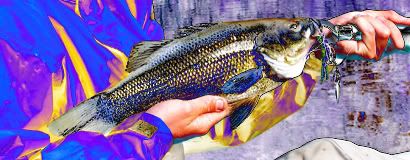
Over the last couple of years i have developed a love for Bass fishing in the many rivers along the South coast of NSW, these rivers are one of the most peacefull places you can find which makes the experience even more enjoyable. Bass will take many different lures so i have put together this report to help anyone who hasnt had the satisfaction of luring a nice big wild river Bass.
The first technique i will talk about is surface lures which are very effective during the early morning and late afternoon period especially when there is a lot of insect activity. A few of the most effective surface lures include crawlers which make a great Cicada imitation, Walk the dog type lures which zig-zag accross the surface, and poppers. Casting these lures very close to the bank or other structure such as overhanging trees, and submerged timber or rock is the most likely spots to hold good Bass and will give you the best chance to tempt the fish to the surface for the lure.
Rather than sitting in the deeper water casting straight at the trees or submerged structure, try to position yourself closer to the bank which will allow you to cast and retreive accross the face of the structure which will give your lure more time in the strikezone. Slow to medium retreives usually work best for me, with plenty of long pauses along the way which is often the time a Bass will strike at the lure, sometimes a Bass will hit a surface lure 3 or 4 times before hooking up so if it misses the lure on the first strike there is a good chance it will come back for another attempt so keep the retreive going as normal until the lure is out of the strike zone.
Next on the list is Soft plastic lures which can be very useful when fishing heavily submerged timber or thick overhanging trees because they are cheap compared to hardbody lures and you have the ability to rig them with weedless/snag proof worm hooks. Jighead weight depends on the depth you intend to fish, but you rarely need a jighead heavier than 1/8oz for rivers, 1/16oz or 1/12oz are my preffered weight for soft plastic lures, a Betts spin blade or similar can be added to the jighead for added flash and noise will will often entice a Bass to strike aggresively which will ultimately increase your hookup ratio.
3-4 inch fat grubs, flickbaits and minnows are my most successful types of plastics in natural or darker colours are the choice of many anglers but it pays to have as many colour options as possible. Bass love diving hardbody lures as well, especially those with a bit of body to them.
The fatter crankbait style lures are the most popular, again, the natural or darker colours usually tempt the Bass most consistently.
Cast and retreive accross the face of structure with a slow retreive with plenty of pauses, the same as i have mentioned with the surface lures. While the lure is being retreived, if you feel the lure hit some submerged timber or rock, you can simply pause the retreive and the lure will slowly rise and the retreive can continue once its over the top of the obstacle which will decrease your chance of snagging and losing your lure.
The last lure type i will mention is the spinnerbaits, which are my favourite Bass lure.
Spinnerbaits were designed for fishing structure of all kinds, with their snagless and weedless design you can throw them right into otherwise unfishable locations and quite often this is where you find big Bass. Spinnerbaits can be used at any depth and come in a large range of colours and weights, along with blade styles, colours and amount of blades. I use tandem twin spins the most, which is a colorado blade, with a willow blade directly behind it and usually in a weight of 1/8oz.
I prefer dark colour skirts on spinnerbaits like black with either purple, red or green tips.
Fishing the Bass rivers on the South coast usually means thick overhanging trees with steep banks which is ideal for spinnerbaits, just find a gap in the trees, even a small gap and throw the spinnerbait as far up into it as possible, even right up to the bank if you can get it there and let the lure sink to the bottom then give the rod tip a sharp lift to get the blades spinning and commence with a slow retreive then pause and let the lure sink again, and repeat until the lure is back to you. Bass will often hit the spinnerbait on the drop so always keep an eye on the line and get ready to muscle the fish away from the structure, a big Bass will get you back into the structure before you know it so always be ready for the hit or you will lose lures, and fish.
The key to luring Bass is casting accuracy, the lure must be as close as possible to structure at all times, and when its warm and the sun is high fish the shaded areas thoroughly and you will find Bass. Please remember to always handle the fish with care, and take your camera!!



